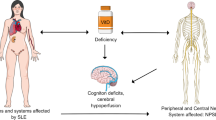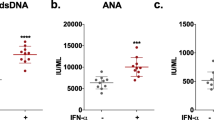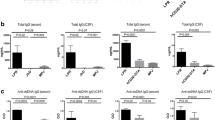Abstract
Introduction/objectives
Patients with systemic lupus erythematosus (SLE) may have neurological complications, characterizing neuropsychiatric lupus (NPSLE). Studies have investigated alternative therapies such as vitamin D, which has an effect on the immune system and brain, to control manifestations of SLE. Experimental lupus models may be a good alternative to best study the immunological mechanisms underlying the development of NPSLE, and the animal model of pristane-induced lupus (PIL) may mimic SLE symptoms in humans. Our objective was to evaluate central nervous system involvement and vitamin D supplementation in a PIL model.
Method
Female BALB/c mice were divided into controls (CO; n = 7), PIL (n = 9), and PIL supplemented with vitamin D (VD; n = 7). The hippocampus area was measured and immunoassays were performed for detecting vitamin D receptor (VDR) and IgG.
Results
The PIL group had a higher hippocampal IgG infiltrate when compared to the CO group. Vitamin D showed potential for reducing IgG infiltration. The hippocampus area was similar in all groups. No differences in VDR expression were observed between groups. A positive correlation was observed between the expression of VDR and IgG in the hippocampus.
Conclusion
Our data suggest that increased IgG infiltration into the hippocampus indicated an inflammatory process that may have stimulated VDR expression.
Key Points • IgG infiltrate is higher in PIL animals than controls • VDR increases along with IgG infiltrate • Hippocampal VDR expression does not increase with vitamin D supplementation |




Similar content being viewed by others
References
D’Cruz DP, Khamashta MA, Hughes GRV (2007) Systemic lupus erythematosus. Lancet 369:587–96. https://doi.org/10.1016/S0140-6736(07)60279-7
Uva L, Miguel D, Pinheiro C, Freitas JP, Marques Gomes M, Filipe P (2012) Cutaneous manifestations of systemic lupus erythematosus. Autoimmune Dis. 2012:834291. https://doi.org/10.1155/2012/834291
Tsokos GC, Lo MS, Reis PC, Sullivan KE (2016) New insights into the immunopathogenesis of systemic lupus erythematosus. Nat Rev Rheumatol 12:716–730. https://doi.org/10.1038/nrrheum.2016.186
Reumatologia SB de (2011) Lúpus. https://www.reumatologia.org.br/orientacoes-ao-paciente/lupus-eritematoso-sistemico-les-cartilha-da-sbr/. Accessed 5 Aug 2020
Ginzler E, Tayar J (2013) Systemic lupus erythematosus. Am Coll Rheumatol 1–6. https://doi.org/10.1007/SpringerReference_61618
De Boer AG, Gaillard PJ (2006) Blood-brain barrier dysfunction and recovery. J Neural Transm 113:455–462. https://doi.org/10.1007/s00702-005-0375-4
Liang MH, Corzillius M, Bae SC et al (1999) The American College of Rheumatology nomenclature and case definitions for neuropsychiatric lupus syndromes. Arthritis Rheum 42:599–608. https://doi.org/10.1002/1529-0131(199904)42:4%3c599::AID-ANR2%3e3.0.CO;2-F
Adorini L (2002) Immunomodulatory effects of vitamin D receptor ligands in autoimmune diseases. Int Immunopharmacol 2:1017–1028
Chen S, Sims GP, Chen XX et al (2007) Modulatory effects of 1,25-dihydroxyvitamin D3 on human B cell differentiation. J Immunol 179:1634–1647
Casseb GAS, Kaster MP, Rodrigues ALS (2019) Potential role of vitamin D for the management of depression and anxiety. CNS Drugs 33:619–637. https://doi.org/10.1007/s40263-019-00640-4
Deluca GC, Kimball SM, Kolasinski J et al (2013) Review: the role of vitamin D in nervous system health and disease. Neuropathol Appl Neurobiol 39:458–484
Trinko JR, Land BB, Solecki WB et al (2016) Vitamin D3: a role in dopamine circuit regulation, diet-induced obesity, and drug consumption. eNeuro 3:226–231. https://doi.org/10.1523/ENEURO.0122-15.2016
Aranow C (2011) Vitamin D and the immune system. J Investig Med 59:881–886. https://doi.org/10.1533/9780857095749.2.244
Yap KS, Morand EF (2015) Vitamin D and systemic lupus erythematosus: continued evolution. Int J Rheum Dis 18:242–249. https://doi.org/10.1111/1756-185X.12489
Eyles DW, Smith S, Kinobe R et al (2005) Distribution of the vitamin D receptor and 1 alpha-hydroxylase in human brain. J Chem Neuroanat 29:21–30. https://doi.org/10.1016/j.jchemneu.2004.08.006
Häusler D, Weber MS (2019) Vitamin D supplementation in central nervous system demyelinating disease-enough is enough. Int J Mol Sci 20(1):218. https://doi.org/10.3390/ijms20010218
Jagannath VA, Filippini G, Di Pietrantonj C, Asokan GV, Robak EW, Whamond L, Robinson SA (2018) Vitamin D for the management of multiple sclerosis. Cochrane Database Syst Rev 9(9):CD008422. https://doi.org/10.1002/14651858.CD008422.pub3
VanAmerongen BM, Dijkstra CD, Lips P, Polman CH (2004) Multiple sclerosis and vitamin D: an update. Eur J Clin Nutr 58:1095–1109
Pierrot-Deseilligny C, Souberbielle JC (2011) Widespread vitamin D insufficiency: a new challenge for primary prevention, with particular reference to multiple sclerosis. Presse Med 40:349–356
Pierrot-Deseilligny C, Souberbielle JC (2017) Vitamin D and multiple sclerosis: an update. Mult Scler Relat Disord 14:35–45
Freitas EC, de Oliveira MS, Monticielo OA (2017) Pristane-induced lupus: considerations on this experimental model. Clin Rheumatol 36:2403–2414. https://doi.org/10.1007/s10067-017-3811-6
Luciano-Jaramillo J, Sandoval-García F, Vázquez-Del Mercado M et al (2019) Downregulation of hippocampal NR2A/2B subunits related to cognitive impairment in a pristane-induced lupus BALB/c mice. PLoS ONE 14:e0217190. https://doi.org/10.1371/journal.pone.0217190
Kokic V, Martinovic Kaliterna D, Radic M et al (2018) Association between vitamin D, oestradiol and interferon-gamma in female patients with inactive systemic lupus erythematosus: a cross-sectional study. J Int Med Res 46:1162–1171. https://doi.org/10.1177/0300060517734686
Satoh M (1994) Induction of lupus-associated autoantibodies in BALB/c mice by intraperitoneal injection of pristane. J Exp Med 180:2341–2346. https://doi.org/10.1084/jem.180.6.2341
Matheu V, Bäck O, Mondoc E, Issazadeh-Navikas S (2003) Dual effects of vitamin D-induced alteration of TH1/TH2 cytokine expression: enhancing IgE production and decreasing airway eosinophilia in murine allergic airway disease. J Allergy Clin Immunol 112:585–592
Correa Freitas E, Evelyn Karnopp T, de Souza Silva JM et al (2019) Vitamin D supplementation ameliorates arthritis but does not alleviates renal injury in pristane-induced lupus model. Autoimmunity 52:69–77. https://doi.org/10.1080/08916934.2019.1613383
La Paglia GMC, Leone MC, Lepri G et al (2017) One year in review 2017: systemic lupus erythematosus. Cilinical Exp Rheumatol 35:551–561
Yan L, Wu P, Gao D-M et al (2019) The impact of vitamin D on cognitive dysfunction in mice with systemic lupus erythematosus. Med Sci Monit 25:4716–4722. https://doi.org/10.12659/MSM.915355
Ballok DA, Millward JM, Sakic B (2003) Neurodegeneration in autoimmune MRL-lpr mice as revealed by Fluoro Jade B staining. Brain Res. https://doi.org/10.1016/S0006-8993(02)03980-X
Zameer A, Hoffman SA (2004) B and T cells in the brains of autoimmune mice. J Neuroimmunol 146:133–139. https://doi.org/10.1016/j.jneuroim.2003.10.052
Sled JG, Spring S, Van Eede M et al (2009) Time course and nature of brain atrophy in the MRL mouse model of central nervous system lupus. Arthritis Rheum 60:1764–1774. https://doi.org/10.1002/art.24523
Abbott NJ, Mendonça LL, Dolman DE (2003) The blood-brain barrier in systemic lupus erythematosus. Lupus 12(12):908–15. https://doi.org/10.1191/0961203303lu501oa
Stojanovich L, Smiljanich-Miljkovich D, Omdal R, Sakic B (2009) Neuropsychiatric lupus and association with cerebrospinal fluid immunoglobulins: a pilot study. Isr Med Assoc J 11:359–362
Wen J, Xia Y, Stock A et al (2013) Neuropsychiatric disease in murine lupus is dependent on the TWEAK/Fn14 pathway. J Autoimmun 43:44–54. https://doi.org/10.1016/j.jaut.2013.03.002
Lam V, Takechi R, Pallabage-Gamarallage M, et al (2015) The vitamin D, ionised calcium and parathyroid hormone axis of cerebral capillary function: therapeutic considerations for vascular-based neurodegenerative disorders. PLoS One 10: https://doi.org/10.1371/journal.pone.0125504
Bivona G, Gambino CM, Iacolino G, Ciaccio M (2019) Vitamin D and the nervous system. Neurol Res 41:827–835
Molinari C, Morsanuto V, Ghirlanda S, et al (2019) Role of combined lipoic acid and vitamin D3 on astrocytes as a way to prevent brain ageing by induced oxidative stress and iron accumulation. Oxid Med Cell Longev 2019: https://doi.org/10.1155/2019/2843121
Mak A (2018) The impact of vitamin D on the immunopathophysiology, disease activity, and extra-musculoskeletal manifestations of systemic lupus erythematosus. Int J Mol Sci 19(8):2355. https://doi.org/10.3390/ijms19082355
Almerighi C, Sinistro A, Cavazza A et al (2009) 1α,25-Dihydroxyvitamin D3 inhibits CD40L-induced pro-inflammatory and immunomodulatory activity in human monocytes. Cytokine 45:190–197. https://doi.org/10.1016/j.cyto.2008.12.009
Schoenmakers I, Jones KS (2017) Pharmacology and pharmacokinetics. In: Hewison M, Bouillon R, Giovannucci E, Goltzman D (ed) Vitamin D: biochemistry, physiology and diagnostics, 4th edn. Amsterdam, pp 636–663
Rolf L, Muris AH, Hupperts R, Damoiseaux J (2014) Vitamin D effects on B cell function in autoimmunity. Ann N Y Acad Sci 1317:84–91. https://doi.org/10.1111/nyas.12440
Chen S, Sims GP, Chen XX et al (2007) Modulatory effects of 1,25-dihydroxyvitamin D 3 on human B cell differentiation. J Immunol 179:1634–1647. https://doi.org/10.4049/jimmunol.179.3.1634
Zhuang H, Szeto C, Han S, et al (2015) Animal models of interferon signature positive lupus. Front Immunol 6:. https://doi.org/10.3389/fimmu.2015.00291
Karnopp TE, Chapacais GF, Freitas EC, Monticielo OA (2021) Lupus animal models and neuropsychiatric implications. Clin Rheumatol 40:2535–2545. https://doi.org/10.1007/s10067-020-05493-7
Jeltsch-David H, Muller S (2014) Neuropsychiatric systemic lupus erythematosus: pathogenesis and biomarkers. Nat Rev Neurol 10:579–596. https://doi.org/10.1038/nrneurol.2014.148
Richard ML, Gilkeson G (2018) Mouse models of lupus: what they tell us and what they don’t. Lupus Sci Med 5:e000199. https://doi.org/10.1136/lupus-2016-000199
Acknowledgements
We would like to acknowledge the pathologist Francine Hehn de Oliveira, Chief of Surgical Pathology—Hospital de Clínicas de Porto Alegre, for all the assistance; the Experimental Pathology Unit and Animal Experimentation Unit at Hospital de Clínicas de Porto Alegre; and Coordenação de Aperfeiçoamento de Pessoal de Nível Superior (CAPES), Brazil, for a scholarship offered to Thaís Evelyn Karnopp.
Funding
This study was supported by the Research Incentive Fund (FIPE/HCPA) under Grant (No. 18–0246); Conselho Nacional de Desenvolvimento Científico e Tecnológico Universal MCTI/CNPQ under Grant (No. 28/2018); and Research Support Fund of Sociedade de Reumatologia do Rio Grande do Sul.
Author information
Authors and Affiliations
Corresponding author
Ethics declarations
Disclosures
None.
Additional information
Publisher's note
Springer Nature remains neutral with regard to jurisdictional claims in published maps and institutional affiliations.
Rights and permissions
About this article
Cite this article
Karnopp, T.E., Freitas, E.C., Rieger, A. et al. Higher IgG level correlated with vitamin D receptor in the hippocampus of a pristane-induced lupus model. Clin Rheumatol 41, 1859–1866 (2022). https://doi.org/10.1007/s10067-022-06094-2
Received:
Revised:
Accepted:
Published:
Issue Date:
DOI: https://doi.org/10.1007/s10067-022-06094-2




